Twitter accounts disproportionately amplified Chilean presidential candidate hashtags
Analysis of hashtags supporting both presidential candidates shows activity highly concentrated among a small percentage of accounts.
Twitter accounts disproportionately amplified Chilean presidential candidate hashtags
Share this story
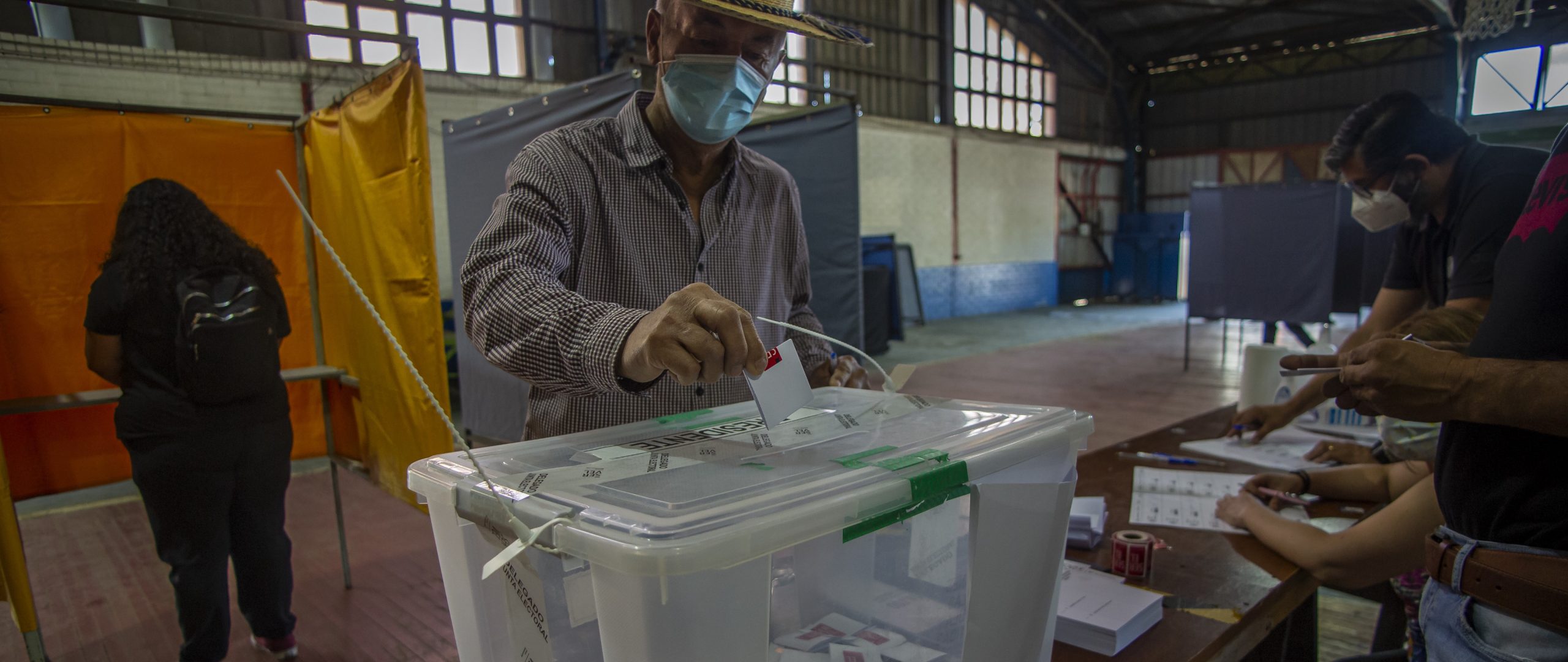
BANNER: A Chilean man places his vote in the ballot box during the second round of the presidential elections in Maipú, Chile on December 19, 2021. (Source: Reuters/Claudio Arbaca Sandoval/NurPhoto)
An analysis of different hashtags supporting presidential candidates Gabriel Boric and José Antonio Kast ahead of Chile’s December 2021 presidential runoff showed that only a few accounts were responsible for most of the posts using them. Hashtags that were related to the elections but not to specific candidates did not show the same pattern of concentration.
Leftist Gabriel Boric was elected on December 19, 2021 with 56 percent of the vote, compared to 44 percent received by his far-right opponent, José Antonio Kast. Disinformation and influence operations took a central role in the final stages of the campaign, with Kast — associated in the past with influence operations on Twitter — and his supporters being accused of staging these operations.
Measuring the concentration of tweets improves understanding of how hashtags reach Twitter’s trending topics when boosted by a relatively small group of people, usually through coordination. This methodology, however, does not allow for confirming (or rejecting) the use of bots or inauthentic behavior in the amplification of hashtags.
The DFRLab analyzed six hashtags related to each candidate and found that around 5 percent of pro-Boric accounts and 9 percent of pro-Kast accounts using them were responsible for more than 60 percent of all tweets. Nearly 2 million tweets were analyzed, ranging from November 22, one day after the first round of the presidential elections, through December 19, the day of the presidential runoff.
Measuring the concentration of tweets
In order to measure the concentration of tweets, the DFRLab collected posts supporting either Boric or Kast, choosing six different hashtags and their variants for each candidate that reached the national trending topics.
Among the pro-Boric hashtags, the DFRLab analyzed #BoricPresidente2022 (“Boric President 2022”), #BoricPresidenteDeChile2022 (“Boric President of Chile 2022”), #BoricPresidente (“Boric President”), #BoricNosUne (“Boric Unites Us”), #TodosConBoric (“All with Boric”), and #ChileVotaPorBoric (“Chile votes for Boric”).
Twitter activity of these hashtags showed a peak of mentions between December 10 and December 14, a few days before the second round of the presidential elections. On December 19, the number of mentions increased again, likely related to Boric’s victory in the elections.
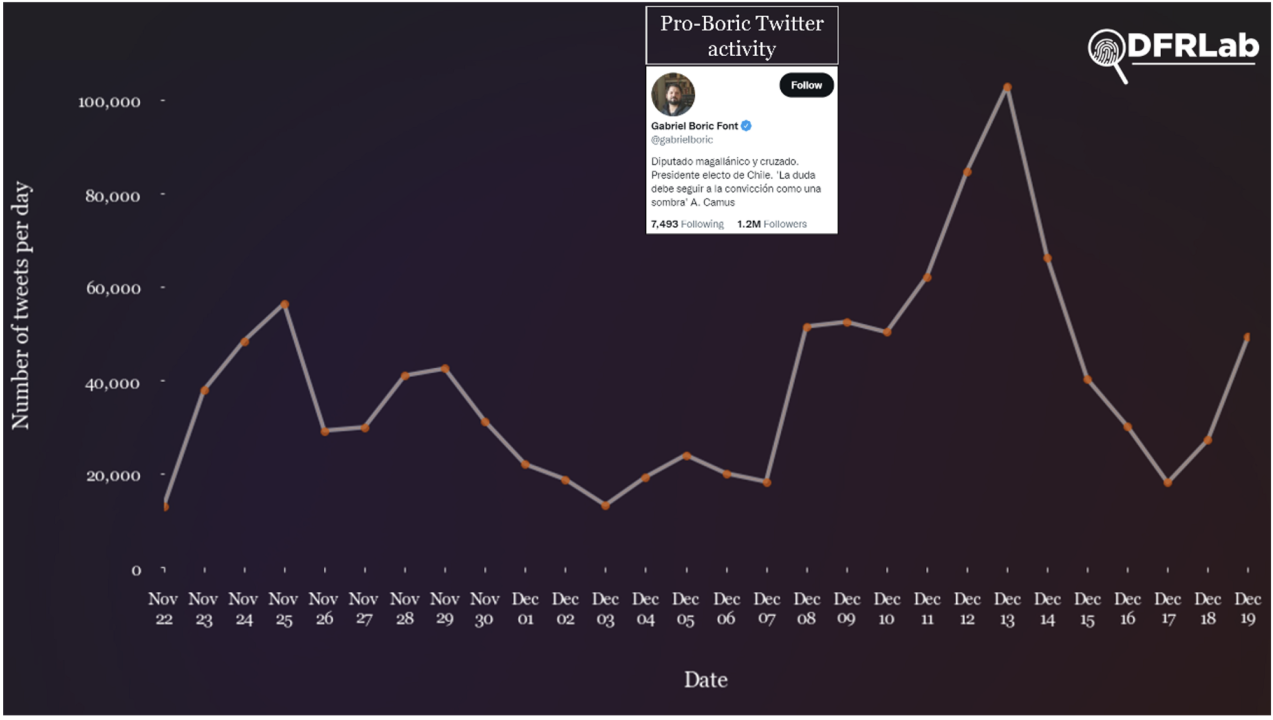
Among the pro-Kast/anti-Boric hashtags, we analyzed #TodoChileVotaKast (“All Chile votes Kast”), #KastPresidenteDeChile2022 (“Kast President of Chile 2022”), #BoricAcosador (“Boric harasser”), #BoricAcosadordeMujeres (“Boric Women Harasser”), #BoricNoSeAtreveDebatir (“Boric does not dare debating”), and #BoricNoSeAtreveADebatir (“Boric does not dare to debate”).
While both #TodoChileVotaKast and #KastPresidentedeChile2022 highlighted general support for Kast, those mentioning Boric were negative hashtags related to two different topics: first, an allegation of harassment against Boric that supposedly took place in 2012 (an allegation he denies), and second, a reference to Boric’s decision not to participate on some debates.
Although the pro-Boric hashtags in our dataset comprised more tweets in overall volume in the analyzed period, pro-Kast/anti-Boric hashtags garnered more mentions in the first week following the first round of the presidential elections. Two more peaks of mentions happened on different days in December.
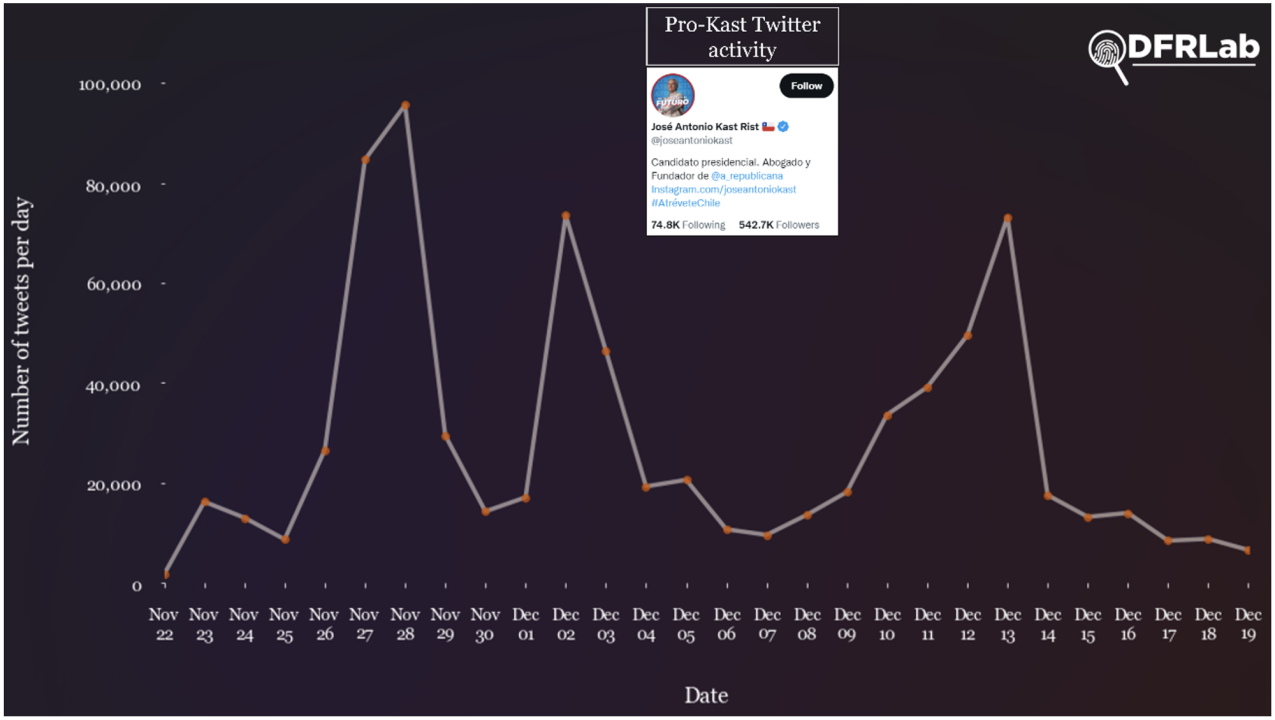
Gini index applied to social media activity
The analysis of concentration was made using the Gini index, which is usually applied to understand income inequality in different countries, as it shows how income is concentrated in different groups within the designated country. The Gini index calculates the level of inequality in a designated country, giving it a number between 0 and 1, where 0 represents perfect equality (i.e., wealth is perfectly and evenly distributed) and 1 represents complete inequality (i.e., wealth is completely unequal in distribution, with a vast majority concentrated in an extremely small number of people). For example, according to the World Bank, the most unequal country in the world, where wealth is concentrated in the fewest number of people, is South Africa, which had a Gini index of 0.63.
In this case, however, the DFRLab calculated the Gini index for the concentration of each of the hashtags, using a methodology that was first applied by Brazilian independent outlet Núcleo Jornalismo. (The script used for calculating the Gini can be seen here, with comments in Portuguese.) The resulting number indicated concentration of tweet volume by Twitter accounts per hashtag. Other methodologies to measure manipulation of trends on Twitter, such as the Coefficient of Traffic Manipulation, also included a component that attempted to assess the concentration of tweets.
The analysis found an aggregate Gini of 0.80 for pro-Boric hashtags and 0.81 for pro-Kast hashtags, on a scale from 0 to 1. This indicates high concentration within a limited number of accounts.
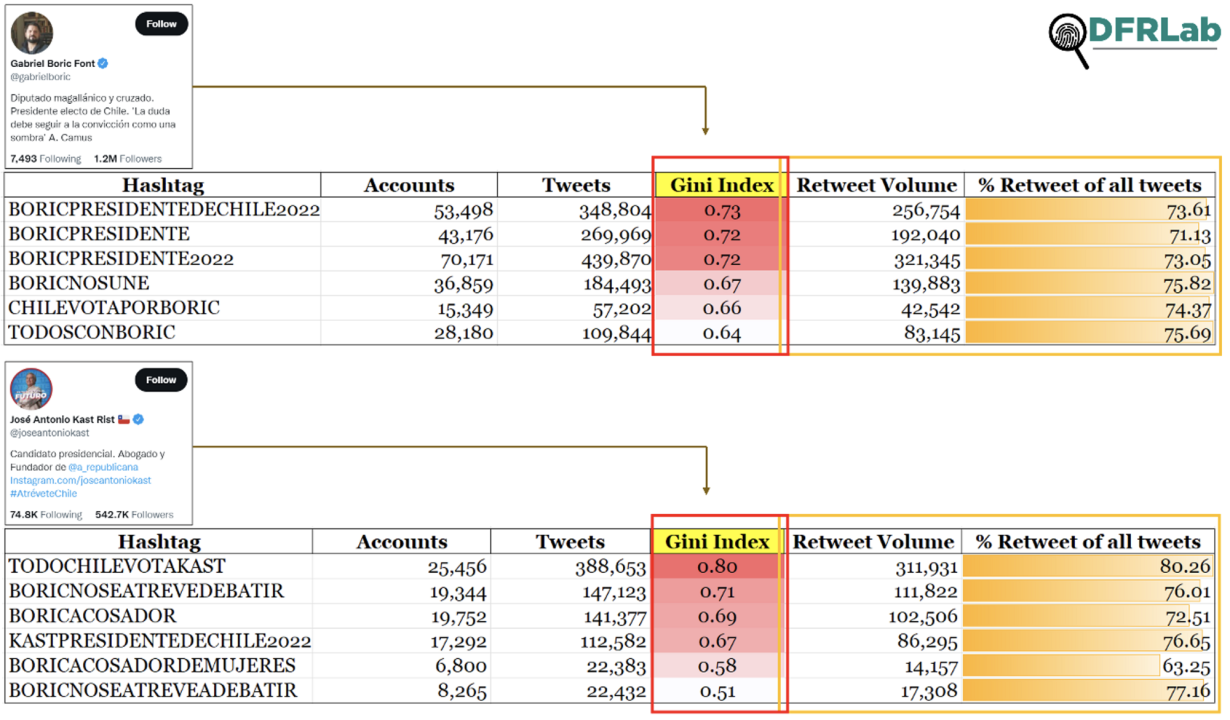
The DFRLab also analyzed Twitter activity for politically neutral hashtags. These hashtags contained only keywords referencing the Chilean elections and did not support or attack specific candidates. Among these were #Elecciones2021CL (“Elections 2021 CL”), #EleccionesChile2021 (“Elections Chile 2021”), and #EleccionesChile (“Elections Chile”).
For this group of hashtags, the DFRLab collected around 400,000 tweets posted between December 13 and 19, 2021. The Gini index for these individual hashtags ranged between 0.26 and 0.54, showing lower concentration scores compared to those hashtags supporting the individual presidential candidates.

Utilizing Núcleo Journalismo’s methodology, the DFRLab also calculated the number of accounts that had tweeted the hashtags more than 50 times. According to these results, 5 percent of pro-Boric accounts were responsible for 62% of tweets using pro-Boric hashtags, while 9 percent of pro-Kast accounts were responsible for 70 percent of tweets using pro-Kast/anti-Boric hashtags.

A subset of accounts that contributed to these hashtags were created between the first and second rounds of the presidential election. For instance, pro-Boric hashtags amassed more than 100,000 unique accounts, while pro-Kast amassed nearly 40,000. In the case of accounts supporting Boric, hundreds were created between November 21 and 26.
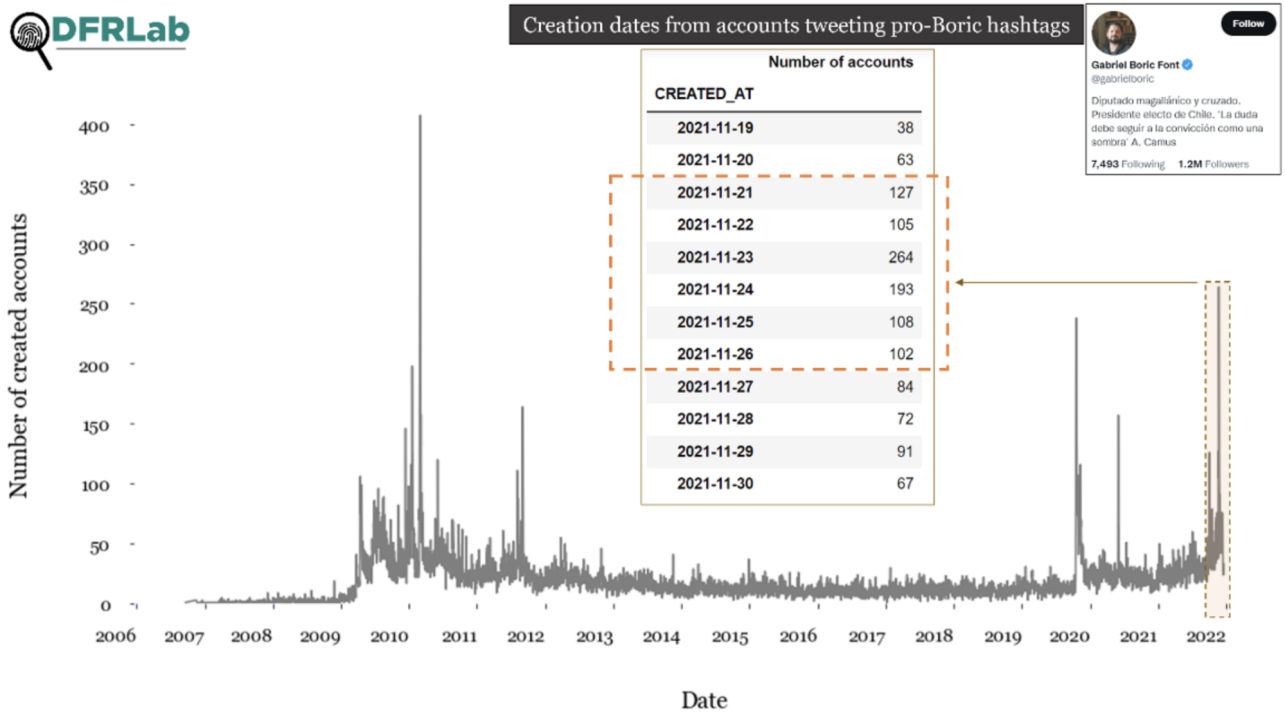
The same pattern occurred for accounts supporting Kast, with a peak of new accounts being created after the first round of the presidential elections.
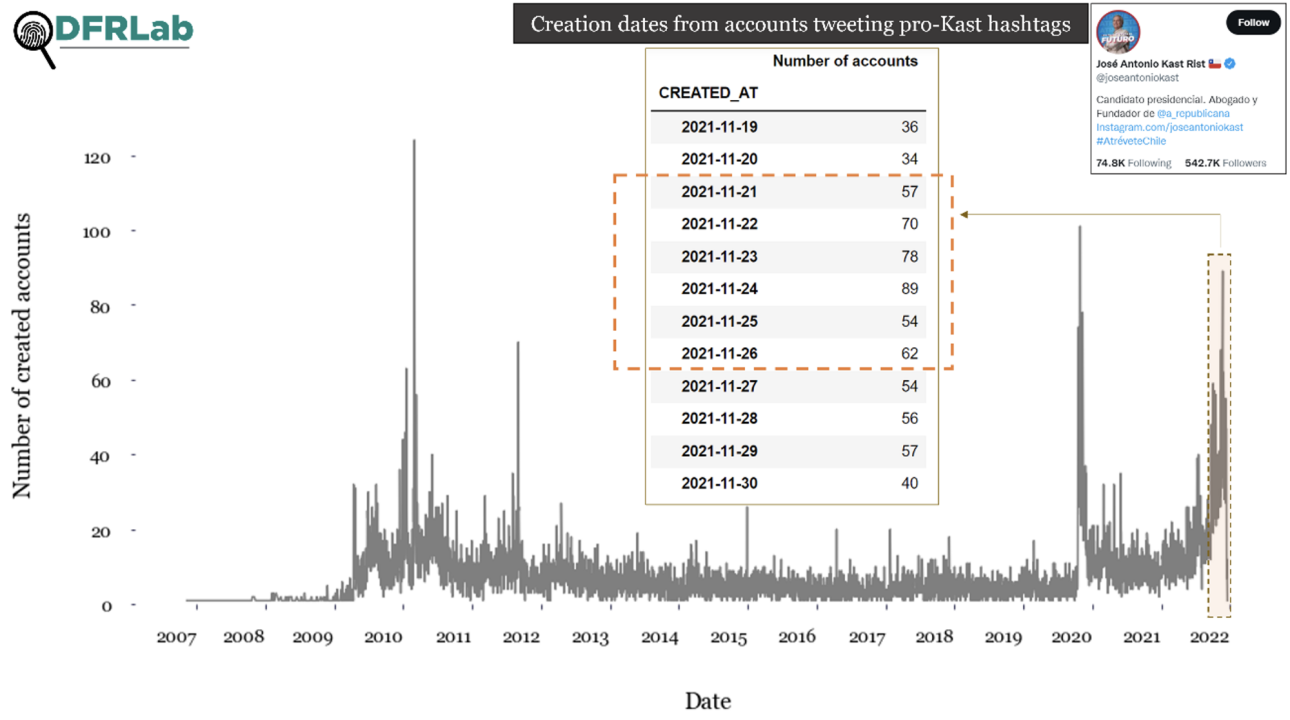
Coordination via “tweetathons”
The concentration of tweets mentioning a hashtag to a select number of accounts does not necessarily imply the use of automation or other forms of inauthentic behavior, although some accounts might have broken Twitter’s spam and manipulation policy. Still, they illustrate a strategy used to amplify certain debates online. Some of the hashtags analyzed trended as a clear result of coordination, occurring through calls to actions or “tweetathons.”
On Kast’s side, that was the case with #TodoChileVotaKast and #BoricNoSeAtreveDebatir. The former was championed by @Zafiro20201, an account whose ownership is unknown. The account does not carry the name of a person and uses generic pictures of Kast and his campaign slogan in its profile.
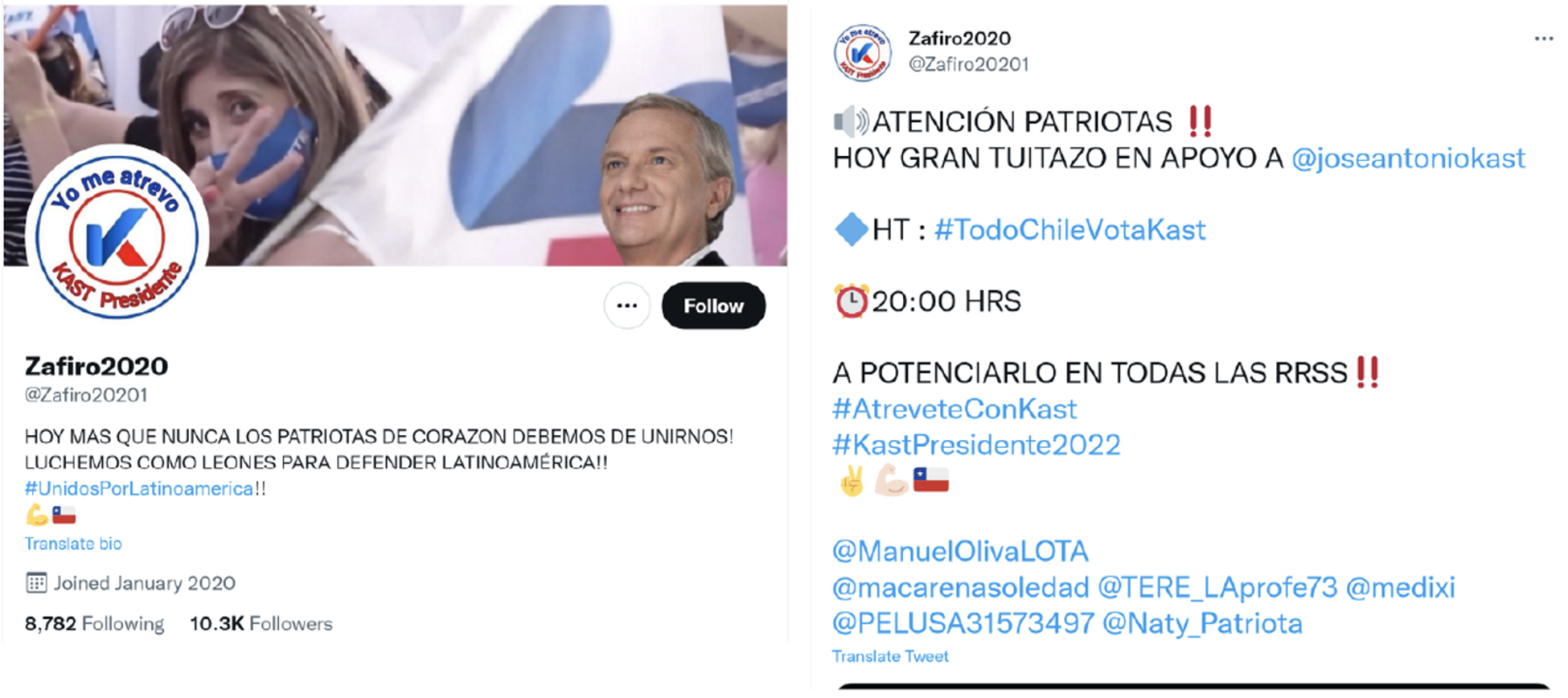
The second, #BoricNoSeAtreveDebatir (“Boric does not dare debating,” a play on words in reference to Kast’s campaign slogan), also trended as a result of a coordinated effort instigated by Sergio Melnick, a government minister during the Pinochet dictatorship who is a strong supporter of Kast’s candidacy. Melnick posted the call to action around the hashtag on December 1, asking his followers to use it “until it is a trending topic.” His post was the most retweeted one using the hashtag, which trended in Chile on December 2, 3, and 4. The DFRLab identified Melnick as one of the main influencers boosting pro-Kast trends in a previous article about the Chilean election.
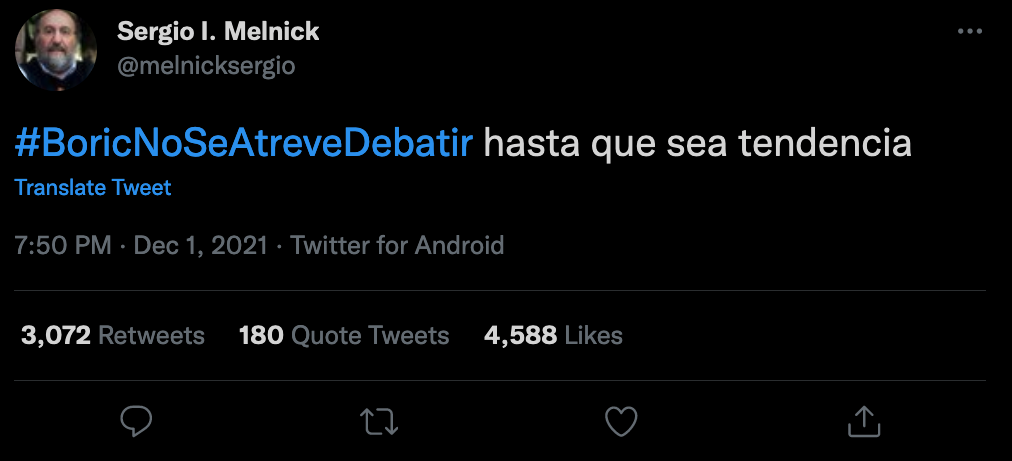
On Boric’s side, #ChileVotaPorBoric and #BoricPresidente were connected to coordinated calls. The former was instigated by the account @FrenteRebeldes (“Rebel Front”), which describes itself in its bio as a page that “creates trends.” The bio also links to a Telegram channel with some 700 followers that promotes pro-Boric Twitter trends, among others.

The second pro-Boric hashtag, #BoricPresidente, had already been used prior to the election. It remained in use by many influencers and politicians, including a November 20 call-to-action tweet that promised that the authoring account’s operator would donate food to charity if the post reached 1,000 retweets.

Most active hashtags
The account that tweeted Kast-related hashtags most often was @progreB, an automated account that describes itself as a bot that retweets “anti-progressive” content. Among the most active accounts were so-called “patriotic trolls,” such as @octopusCL and @HaraldHwolvesh, some of which used generic images as profile pictures, a possible sign of inauthenticity.
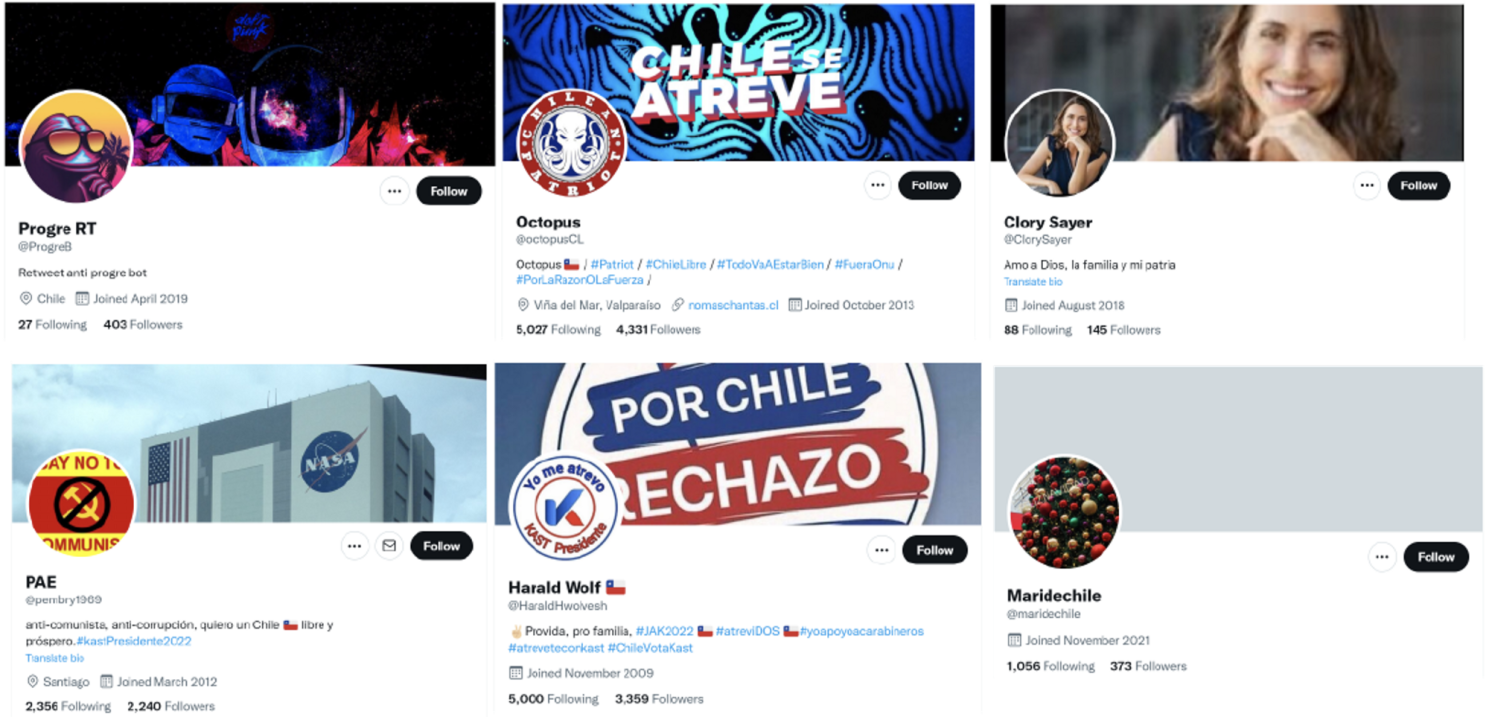
On the Boric side, the most active account was @PrensaAltG, the media page of a movement that claims to seek “alternative globalization.” The account, which became hyperactive in the electoral period, was offline by December 23, indicating that it was probably suspended by Twitter. Among the most active accounts were also some with pictures of animals and other general images.
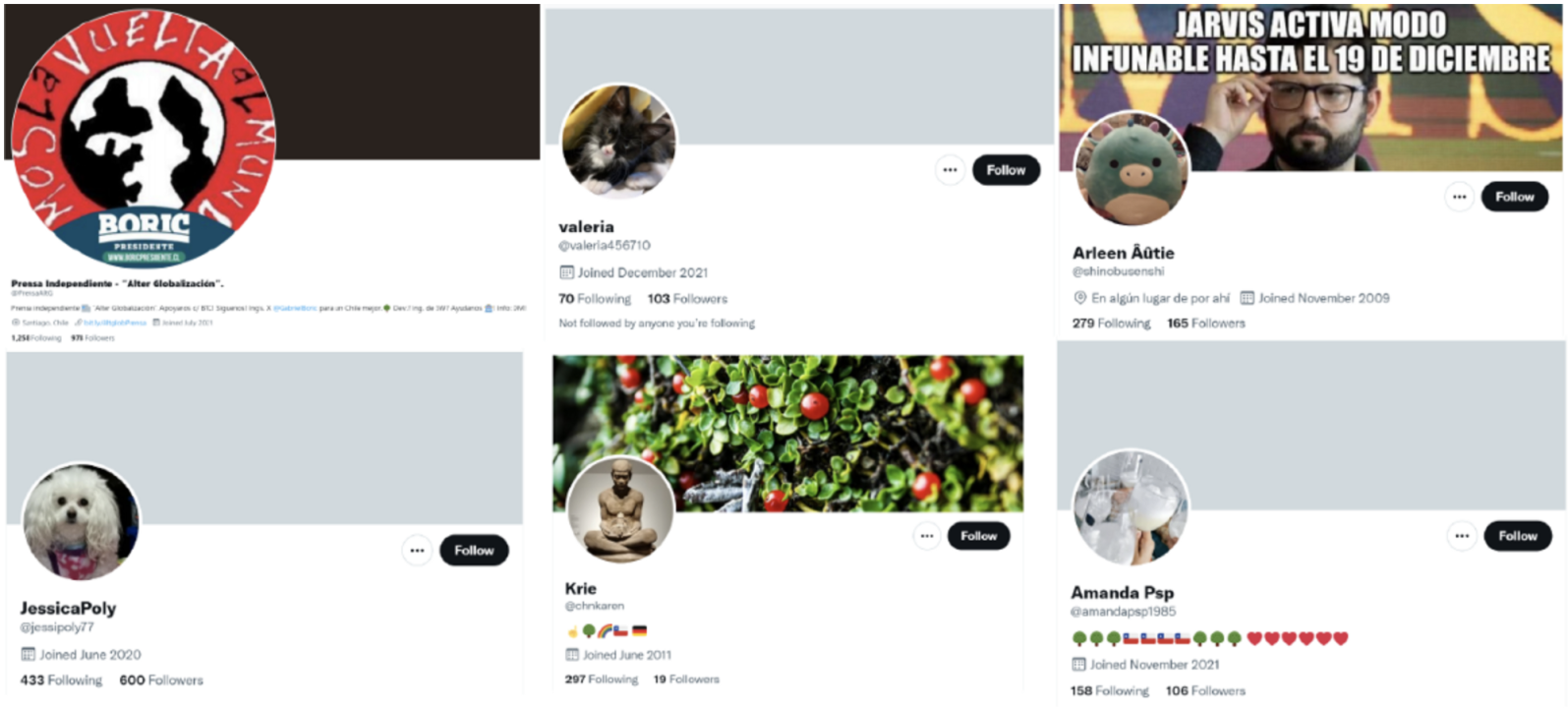
Hashtags supporting both candidates in Chile’s second round of presidential elections — the one previously connected to influence operations and the one who had not been — were highly concentrated among a small minority of accounts, suggesting that, in electoral periods, the concentration of tweets in campaigns supporting candidates might be the norm on both sides of the political spectrum. Future research could help identify whether both campaigns used organic efforts to reach the trending topics, or if one campaign relied more on automated or inorganic means.
Cite this case study:
Esteban Ponce de León and Luiza Bandeira, “Twitter accounts disproportionately amplified Chilean presidential candidate hashtags,” Digital Forensic Research Lab (DFRLab), January 12, 2022, https://medium.com/dfrlab/twitter-accounts-disproportionately-amplified-chilean-presidential-candidate-hashtags-6f513369be8d.

